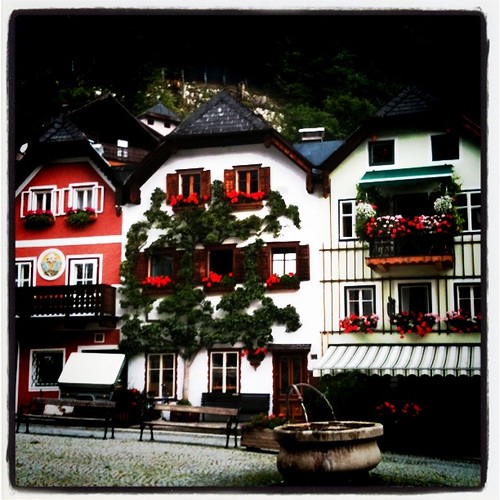 Hallstatt is one of my favorite attractions in Austria. It’s about an hour’s drive from the husband’s home turf. We’ve made a trip there almost every time we’re in Austria and we always take visitors there. It’s shockingly pretty, sometimes it is hard to accept that a place can be real and be so pretty, but it is real indeed.
Hallstatt is one of my favorite attractions in Austria. It’s about an hour’s drive from the husband’s home turf. We’ve made a trip there almost every time we’re in Austria and we always take visitors there. It’s shockingly pretty, sometimes it is hard to accept that a place can be real and be so pretty, but it is real indeed.
Humans have occupied this little village on the edge of the lake for thousands of years. There are the remains of a Roman bath below a central souvenir store and if you like, you can tour the salt mines. Life wasn’t always so pretty here — twice a day women lugged great amounts of salt up and down the steep mountain face where there’s now a funicular and men worked in oily darkness underground to extract that salt.
Now it’s touristy as all get out, but even the scented soaps and overpriced coffee and keyfobs that feature little bears wearing lederhosen can’t tarnish Hallstatt’s appeal. Maybe a bus of Taiwanese tourists will fill the dining room at the Zauner, a traditional restaurant tucked back in the corner of Hallstatt’s main square, but that doesn’t change the fact that the flower boxes are bursting with geraniums in neon colors. You may need to wait for a clot of Germans to clear the overlook, but once they have, you can still see the village reflected in the mirror of the lake, surrounded by great towering mountains.
Recently, a Chinese delegation came to Hallstatt to document the daylights out of the place. Their goal was to replicate this alpine confection in China. It’s a weird idea, but so is Paris and Venice in Vegas.
While we were wandering into Hallstatt, we encountered a chatty and somewhat absent minded grandmother who pointed up at the stone and age blackened timber home in front of us. “It’s the oldest house in Hallstatt!” she said, repeatedly. “Yours?” asked J, and she laughed. “No, no, no. I just have a little bird house of a place! This is a grand house for Hallstatt, it’s the oldest one in town, you know.” “Ask her about the Chinese…” I whispered to J and he did. “Oh! They should take MY picture too, so they have a copy of ME in this ‘new’ Hallstatt!!” She laughed some more. Her face was very sweet. She pointed up at the house again. “It’s the oldest house in Hallstatt, you know…” “She’s in a loop,” I whispered to J, and he wished her a pleasant afternoon. She brightened, snapped back into focus. “You too, all of you, thank you!” and we wandered on.
During lunch at the Zauner, we sat on the balcony — the dining rooms were reserved for large groups of Taiwanese and German tourists. Below us, three Japanese girls, each wearing some kind of hot pink item — sneakers, a hair ribbon, a sweater — took pictures of themselves next to an ornate window.
The waiter — the same waiter I had last time I ate lunch at the Zauner — indulged me. “They should go ahead,” he said. “The Chinese who have enough money will come here to see the REAL Hallstatt. The rest, well, they can stay in China.” He sputtered a little, and shrugged. “Plus, they can not copy THIS. How can they copy THIS?!” He gestured a little with his hand, hindered by our lunch plates. I nodded, and he rushed off to his overflowing dining room.
